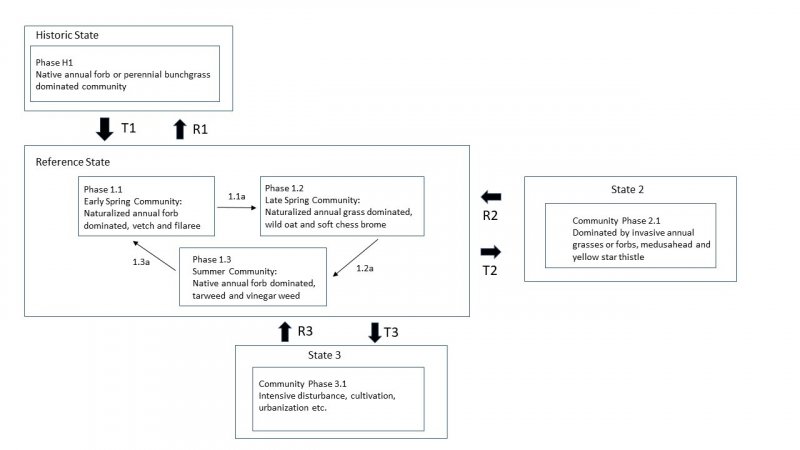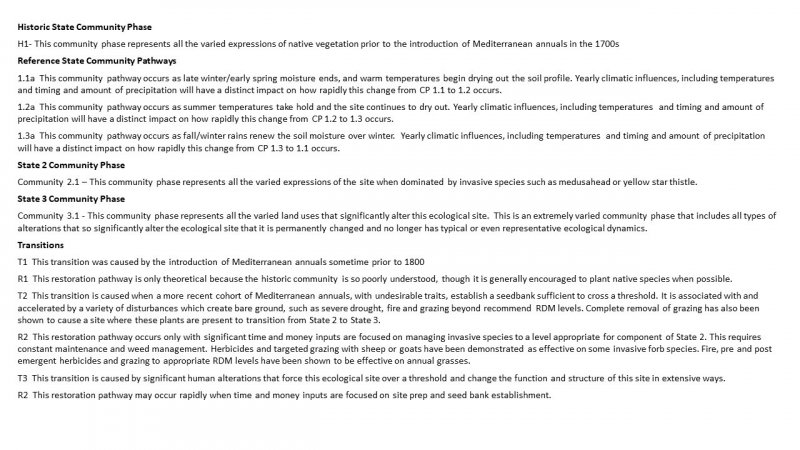Ecological site group R017XY905CAESG
Dry Alluvial Fans
Last updated: 06/03/2024
Accessed: 12/21/2025
Ecological site group description
Key Characteristics
- Landform Not As Above
- Not As Above
- Site Is Not Sub-Irrigated
- MAP ≥ 10"
Provisional. A provisional ecological site description has undergone quality control and quality assurance review. It contains a working state and transition model and enough information to identify the ecological site.
Physiography
This site is on alluvial fans formed by streams originating in the Coast Range, Sierra Nevada, and Cascade Mountains. It may intergrade with similar sites on foothills adjacent to the Central Valley.
Climate
The average annual precipitation is 5 to 12 inches (125 to 305 millimeters) in the San Joaquin Valley. The Tulare Basin, at the southern end of this MLRA, typically receives less than 6 inches (150 millimeters) of rainfall per year. The average annual precipitation is 12 to 30 inches (305 to 760 millimeters) in most of the Sacramento Valley. It is 40 inches (1,015 millimeters) at the higher elevations on the edges of the valley at the north end. Summers are long, hot, and dry, and winters are cool and rainy. Most of the rainfall occurs as low- or moderate intensity, Pacific frontal storms from October to May. Snow is very rare in this MLRA but has occurred in the Sacramento Valley from Sacramento to points farther north. The average annual temperature is 59 to 67 degrees F (15 to 20 degrees C), decreasing from south to north. The freeze-free period averages 325 days and ranges from 280 to 365 days, decreasing in length with elevation and from south to north.
Soil features
These sites are shallower, coarser, or otherwise more droughty than the Deep Alluvial Soils of 17X Group 4, and are associated with Hydologic Soils Groups C and D. They lack the mound and swale topography and the duripan of 17X Group 3.
Some soil series associated with these sites are Corning, Atwater and Hanford.
Vegetation dynamics
This site has been entirely converted or invaded and there are no historic descriptions of it available. There is an ongoing debate as to whether it was principally dominated by perennial grasses or annual forbs. Most of the known early accounts of this site describe it as being dominated by oat grass, an introduced annual.
The principal natural disturbance for the site is seasonal drought cycles, which in conjunction with soil awc, governs the spatial and temporal distribution of plants. Species composition may vary significantly within and between years (Barbour et. al, 2007 and Sawyer and Keeler-Wolf, 1995) and many metrics applied to grasslands in other regions are unsuited to the California annual grassland type.
Rainfall is principally from December to March and the vegetation communities shift in response to available moisture with one phase senescing and being replaced by the next as the dry season progresses.
During the wet season the dominant vegetation is introduced annual forbs including bur clover (Medicago polymorpha), hairy vetch (Vicia vilosa) and filaree (Erodium spp). Shortly after the last rainfall, the community shifts towards annual grasses including wild oat (Avena spp) soft chess brome (Bromus hordeaceus) and Italian ryegrass (Lolium perenes) (Barbour et.al., 2007). A suite of native forbs are adapted to the dry summers and dominate open ground in July and August, including tarweed (Hemizonia and Holocarpha spp.) vinegarweed (Trichostema lanceolatum), and turkey mullen (Croton setigerus) (Ozeran, 2018). After the summer annuals set seed there is no living vegetation until winter rains return and soil moisture levels rise.
These sites are frequently grazed which may affect species composition at the site, though the annual plant community has been shown to be very resilient to grazing to appropriate levels of Residual Dry Matter and grazing is unlikely to cause a transition across a threshold by itself (Bartolome and McClaran, 1992). However, inappropriate grazing, especially in conjunction with severe drought may cause a transition. Removal of livestock, for extended periods, has been shown to promote a medusahead monoculture in the adjacent MLRA 18 (Brownsey et. al., 2016).
Historically Native people and early 20th century ranchers burned this site to promote new growth by removing thatch. This may affect annual species composition but is not currently tied to a threshold.
Restoration efforts are often able to restore annual grassland communities, especially when efforts are focused on site preparation. However, these sites are susceptible to invasion and weed management is necessary.
References/Citations:
Barbour, M., Keeler-Wolf, T., & Schoenherr, A. A. (Eds.). 2007. Terrestrial vegetation of California. Univ of California Press.
Bartolome, J. W., & McClaran, M. P. 1992. Composition and production of California oak savanna seasonally grazed by sheep. Journal of Range Management, 45(1), 103-107.
Brownsey, P., Davy, J., Becchetti, T., Easley, M. L., James, J. J., & Laca, E. A. 2016. Barb Goatgrass and Medusahead: Timing of Grazing and Mowing Treatments.
Keeler-Wolf, T., J.O. Sawyer, and J. Evans. 2009. A Manual of California Vegetation. Edition, 2. California Native Plant Society Press.
Ozeran, R. Sticky, Pungent, and Abundant: Three Summer Range Weeds. UC Weed Science Blog, UC Extension. Accessed at: https://ucanr.edu/blogs/blogcore/postdetail.cfm?postnum=28417. [2023, December 12].
Major Land Resource Area
MLRA 017X
Sacramento and San Joaquin Valleys
Subclasses
- R017XD086CA–SHALLOW LOAMY
- R017XD089CA–ACID TERRACE
- R017XD092CA–LOAMY (BLUE OAK/ANNUAL GRASS)
- R017XE001CA–CLAYEY
- R017XE020CA–FINE LOAMY
- R017XE041CA–Fine Loamy 8-10" P.Z.
- R017XE061CA–Loamy Fan Remnant 8-10" P.Z.
- R017XE080CA–SANDY
- R017XE097CA–SHALLOW SANDY
- R017XE109CA–SHALLOW LOAMY
- R017XE111CA–CLAYEY 12-16"
- R017XE112CA–GRANITIC 14-18"
- R017XE117CA–COBBLY CLAYEY
- R017XE118CA–CALCAREOUS LOAMY
- R017XF072CA–DRY COARSE LOAMY
- R017XF077CA–Loamy Upland 8-10" P.Z.
- R017XY905CA–Dry Alluvial Fans and Terraces
Stage
Provisional
Click on box and path labels to scroll to the respective text.
Ecosystem states
| Historic Transition to Reference Community | - | Historic Transition |
|---|---|---|
| T2 | - | Invasion. |
| T3 | - | Human Alteration |
| R1 | - | Weed Management |
| T3 | - | Human Alteration |
| R2 | - | Restoration w/o Weed Management |
State 1 submodel, plant communities
State 2 submodel, plant communities
| 2.1a | - | Seasonal Change |
|---|---|---|
| 2.2a | - | Seasonal Change |
| 2.3a | - | Season Change |

